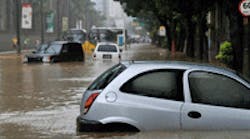When it comes to flooding, everyone is at risk. Aside from heavy rains, flooding can be caused by spring thaws or ice jams; hurricanes and tropical storms; or runoff following a wildfire. To protect yourself, your family and your property, you need to take steps before, during and after a flood.
Before the floodwaters come pouring in:
· Build an emergency kit and make and practice a family emergency plan. Plan and practice flood evacuation routes from home, work and school that are on higher ground.
· Look into getting flood insurance. Remember, flood damage typically is not covered by homeowners insurance. If you have a relatively low risk of flooding, your insurance premiums will be lower.
· Elevate the furnace, water heater and electric panel in your home if you live in an area that has a high flood risk.
· If flooding is expected in your area, listen to the radio or television for information.
· After heavy rains or during periods when flooding is possible, be aware that flash flooding can occur. If there is any possibility of a flash flood, move immediately to higher ground. Do not wait for instructions to move.
If you must evacuate:
· Secure your home. If you have time, bring in outdoor furniture. Move essential items to an upper floor.
· Turn off utilities at the main switches or valves if instructed to do so. Disconnect electrical appliances. Do not touch electrical equipment if you are wet or standing in water.
· When leaving your home, avoid floodwaters. If you come upon a flowing stream where water is above your ankles, turn around and go another way. Six inches of moving water can sweep you off your feet. If you have to walk in water, walk where the water is not moving.
· Do not drive into flooded areas. If floodwaters rise around your car, abandon the car and move to higher ground if you can do so safely. Most vehicles can be swept away by less than 2 feet of moving water.
After the flood:
· Return home only when authorities indicate it is safe.
· Emergency workers will be assisting people in flooded areas. Help them by staying off the roads and out of the way.
· Play it safe. Additional flooding or flash floods can occur. Listen for local warnings and information.
· If your car stalls in rapidly rising waters, get out immediately and climb to higher ground.
· Stay out of any building if it is surrounded by floodwaters. Use extreme caution when entering buildings; there may be hidden damage, particularly in foundations.
· Keep children and pets away from hazardous sites and floodwater.
Cleaning up and repairing your home:
· Before entering your home, look outside for loose power lines, damaged gas lines, foundation cracks or other damage.
· Parts of your home may be collapsed or damaged. Approach entrances carefully and check that porch roofs and overhangs have all their supports.
· If you smell natural or propane gas or hear a hissing noise, leave immediately and call the fire department.
· Turn off the electricity at the main breaker or fuse box, even if the power is off in your community. That way, you can decide when your home is dry enough to turn it back on.
· During cleanup, wear protective clothing, including rubber gloves and rubber boots. Dry or discard wet items within 24-28 hours to avoid mold.
· If using portable generators or power washers, follow proper precautions to prevent carbon monoxide poisoning.
· If you hire cleanup or repair contractors, check references and be sure they are qualified to do the job. Be wary of people who drive through neighborhoods offering help in cleaning up or repairing your home.
· Listen for news reports to learn whether the community's water supply is safe to drink and discard food items that have come in contact with floodwater.
Flooding can create a dangerous, frightening and expensive situation. Follow NSC's tips to be prepared and safe – and stay dry.

